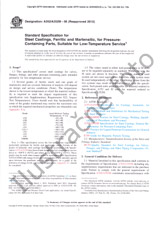Potrebujeme váš súhlas na využitie jednotlivých dát, aby sa vám okrem iného mohli ukazovať informácie týkajúce sa vašich záujmov. Súhlas udelíte kliknutím na tlačidlo „OK“.
ASTM C1468-19a
Standard Test Method for Transthickness Tensile Strength of Continuous Fiber-Reinforced Advanced Ceramics at Ambient Temperature (Includes all amendments and changes 7/10/2019).
NORMA vydaná dňa 1.7.2019
Informácie o norme:
Označenie normy: ASTM C1468-19a
Dátum vydania normy: 1.7.2019
Kód tovaru: NS-953534
Počet strán: 18
Približná hmotnosť: 54 g (0.12 libier)
Krajina: Americká technická norma
Kategória: Technické normy ASTM
Kategórie - podobné normy:
Anotácia textu normy ASTM C1468-19a :
Keywords:
ceramic matrix composite, CFCC, transthickness tension,, ICS Number Code 81.060.30 (Advanced ceramics)
Doplňujúce informácie
| Significance and Use | ||||||||||||||||||||||||
|
4.1 This test method may be used for material development, material comparison, quality assurance, characterization, and design data generation. 4.2 Continuous fiber-reinforced ceramic matrix composites generally are characterized by glass or fine grain-sized (<50 μm) ceramic matrices and ceramic fiber reinforcements. CFCCs are candidate materials for high-temperature structural applications requiring high degrees of corrosion and oxidation resistance, wear and erosion resistance, and inherent damage tolerance, that is, toughness. In addition, continuous fiber-reinforced glass (amorphous) matrix composites are candidate materials for similar but possibly less demanding applications. Although shear test methods are used to evaluate shear interlaminar strength (τ4.3 CFCCs tested in a transthickness tensile test (TTT) may fail from a single dominant flaw or from a cumulative damage process; therefore, the volume of material subjected to a uniform tensile stress for a single uniaxially forced TTT may be a significant factor in determining the ultimate strength of CFCCs. The probabilistic nature of the strength distributions of the brittle matrices of CFCCs requires a sufficient number of test specimens at each testing condition for statistical analysis and design, with guidelines for test specimen size and sufficient numbers provided in this test method. Studies to determine the exact influence of test specimen volume on strength distributions for CFCCs have not been completed. It should be noted that strengths obtained using other recommended test specimens with different volumes and areas may vary due to these volume differences. 4.4 The results of TTTs of test specimens fabricated to standardized dimensions from a particular material, or selected portions of a part, or both, may not totally represent the strength and deformation properties of the entire full-size end product or its in-service behavior in different environments. 4.5 For quality control purposes, results derived from standardized TTT specimens may be considered indicative of the response of the material from which they were taken for given primary processing conditions and post-processing heat treatments. 4.6 The strength of CFCCs is dependent on their inherent resistance to fracture, the presence of flaws, damage accumulation processes, or a combination thereof. Analysis of fracture surfaces and fractography, though beyond the scope of this test method, is highly recommended. |
||||||||||||||||||||||||
| 1. Scope | ||||||||||||||||||||||||
|
1.1 This test method covers the determination of transthickness tensile strength under monotonic uniaxial tensile loading of continuous fiber-reinforced ceramics (CFCC) at ambient temperature. This test method addresses, but is not restricted to, various suggested test specimen geometries, test fixtures, data collection, and reporting procedures. In general, round or square test specimens are tensile tested in the direction normal to the thickness by bonding appropriate hardware to the samples and performing the test. For a Cartesian coordinate system, the 1.2 This test method is intended primarily for use with all advanced ceramic matrix composites with continuous fiber reinforcement: unidirectional (1D), bidirectional (2D), woven, and tridirectional (3D). In addition, this test method also may be used with glass (amorphous) matrix composites with 1D, 2D, and 3D continuous fiber reinforcement. This test method does not directly address discontinuous fiber-reinforced, whisker-reinforced, or particulate-reinforced ceramics, although the test methods detailed here may be equally applicable to these composites. It should be noted that 3D architectures with a high volume fraction of fibers in the “z” direction may be difficult to test successfully. 1.3 Values are in accordance with the International System of Units (SI) and IEEE/ASTM SI 10. 1.4 This standard does not purport to address all of the safety concerns, if any, associated with its use. It is the responsibility of the user of this standard to establish appropriate safety, health, and environmental practices and determine the applicability of regulatory limitations prior to use. 1.5 This international standard was developed in accordance with internationally recognized principles on standardization established in the Decision on Principles for the Development of International Standards, Guides and Recommendations issued by the World Trade Organization Technical Barriers to Trade (TBT) Committee. |
||||||||||||||||||||||||
| 2. Referenced Documents | ||||||||||||||||||||||||
|




 Cookies
Cookies
